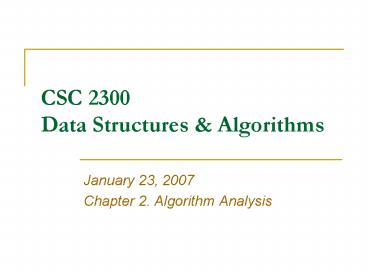CSC 2300 Data Structures - PowerPoint PPT Presentation
Title:
CSC 2300 Data Structures
Description:
... Oh is an upper bound, we must not underestimate the running time of the program. ... is a guarantee that the program will terminate within a certain time period. ... – PowerPoint PPT presentation
Number of Views:38
Avg rating:3.0/5.0
Title: CSC 2300 Data Structures
1
CSC 2300Data Structures Algorithms
- January 23, 2007
- Chapter 2. Algorithm Analysis
2
Today
- Counting operations
- Algorithm analysis
- Order notation
- Running time calculations
3
Example 1 Search
- Sequential search
4
Example 2 Sort
- Insertion Sort
5
Preliminary Analysis
6
Algorithm Analysis Rules
7
Computation Time
8
Typical Growth Rates
9
Order Notation
10
Graph of O(f(n))
11
Graph of T(f(n))
12
Graph of O(f(n))
13
Use of Limits
14
Two Examples
15
Order Notation Manipulation Rules
16
Big-Oh Estimate for Summation
- Evaluate the summation using techniques we have
learned. Then determine an O (or T) estimate from
the resultant function. - Place upper bounds on terms inside the summation
to simplify the terms and eliminate the summation.
17
Running Time Calculations
- We assume no particular units of time. Thus, we
throw away leading constants. - We also throw away low-order terms.
- Since Big-Oh is an upper bound, we must not
underestimate the running time of the program. - Our answer is a guarantee that the program will
terminate within a certain time period. The
program may stop earlier, but never later.
18
Four Rules
- FOR loops
- Nested loops
- Consecutive statements
- If/Else
19
FOR Loops
- The running time of a FOR loop is at most the
running time of the statements inside the FOR
loop (including tests) times the number of
iterations.
20
Nested Loops
- Analyze these inside out. The total running time
of a statement inside a group of nested loops is
the running time of the statement multiplied by
the product of the sizes of all the loops.
21
Consecutive Statements
- These just add, which means that the maximum is
the one that counts.
22
If/Else
- if condition
- S1
- else
- S2
- The running time of an if/else statement is never
more than the running time of the test plus the
larger of the running times of S1 and S2.
23
Two More Examples

